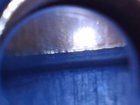@Texas10 correct, 2 rings being discussed. Keeping in mind the following is my opinion...
For the most part, cameras make everything look worse than the really are. If you can control contrast and focus then you have a better chance at seeing what is really going on, but not many cameras have either of those abilities. Same for cleaning - double edge sword on this one. If it is clean you can get a better idea of what the fire cracking/pits/tool marks are really like (fire cracking always looks worse when dirty), but you have to scrub metal to do that. I think shooters forget that barrels are intended to hold up to the heat of the sun, that gun powder is dirty, and that bullets are not all pretty looking when the are being shoved down the barrel at 50k psi. You can take the prettiest barrel ever, the prettiest bullet ever, and by the time you get that pretty bullet to the opposite end of the pretty barrel no matter the method, neither is going to look pretty.
The ring at the end of the case mouth (what the OP was talking about, but what you have as the 'second area') is easy to maintain with a chamber mop. You can get special tools such as
what Bore Tech has or just use a chamber mop on the end of a pistol. I use the Bore Tech kit and have around 10 chamber mops that I rotate and clean. I never have to take a brush to this ring, and I have never had it impede brass, even before I started using a chamber kit.
The ring that starts at the lands is the area that takes the most heat from the powder and primer, and the most abuse from the bullet. Burning propellant is not kind, and squeezing a bullet (yes, they are being severely deformed to get down the barrel) into the barrel is violent. This in turn is whey the area is susceptible to a carbon ring. Unless you scrub it with a bronze brush or something like JB on a regular basis, it is going to happen. But since the things that clean it are also things that can take away metal, some (like me) just try to manage it while the rest of the barrel is getting used up.
The reamers do cut into this area -- a barrel blank has the rifling grooves, but the ends are cut square. The reamer creates the chamber and transition ramp into the rifling, so yes, it cuts a lot of steel. Cutting the gouges (fire cracking) is done by some - they call it setting back. It can be done, but you end up with a shorter barrel (not necessarily a bad thing) but may also be trying to save dollars with quarters. Barrels are consumables, and fire cracking almost always looks worse than it is. I have barrels that would freak people out yet still manage to allow me to pull an occasional 1/4 MOA at 200 - 300, when I am normally a 3/8 - 1/2 MOA shooter.
Some say the carbon ring in the lands changes CBTO. I say even if it did, you will never know it. Even carefully sorted bullets are off by 0.0005 - 0.0010, and by the time you seat them that variance can double. I will also say that erosion pushes the lands out farther and faster than carbon is going to shorten CBTO. The problem with the carbon is it does cause the bullet to get squished more, then released once it gets past the ring. Kind of like putting a speed bump inside the barrel.


















